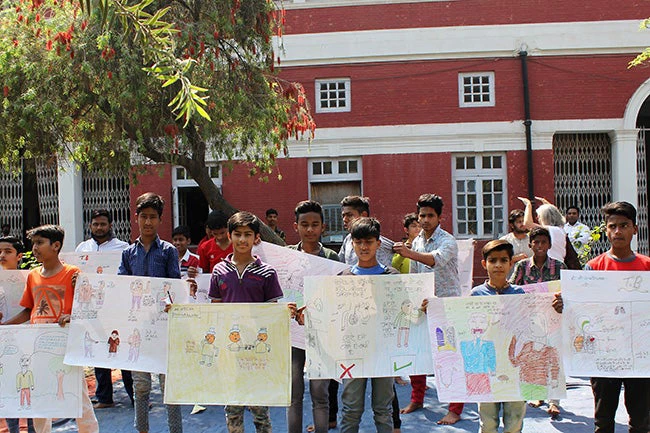
The global community is coming together to tackle an ancient disease that still inflicts interminable human suffering. Globally, one person dies of TB every 20 seconds. While progress has been made over the past decade much remains to be done. Annually, there are still 10.4 million new cases and 1.7 million deaths. One of the key challenges is to find the 4 million missing cases, individuals who develop TB but are missed by health systems and continue to transmit the disease. With the global commitment to end TB, there is a renewed sense of hope in the battle against TB.
Lives and faces behind the numbers
On a hot afternoon in New Delhi, a 45-year old woman explained to visiting guests the devastation unleashed on her family when several members were diagnosed with multi-drug resistant tuberculosis (MDR-TB), a lethal form of the disease. Due to delayed diagnosis and overcrowding, the disease spread to other family members and several succumbed, including the main breadwinner.
Patient testimonies sound strikingly similar in Africa. I recall Justin, a brave Rwandese father of two young children who battled both TB and HIV. His weight dropped to barely 84 pounds, he suffered from anemia, and his immune system was seriously compromised. At the Jamot Hospital in Yaounde, 45-year old Rene recounted how stigma persists and many patients travel hours to reach a facility, often at an advanced stage of the disease.
The global epidemic
The global community has set a laudable target to end TB by 2030. Much remains to be done to reach this target, as progress remains slow. According to the 2017 WHO Report on Global TB Control, TB has now surpassed HIV/AIDS as the leading cause of death from an infectious disease. Seven countries account for 64% of the incident cases (India, Indonesia, China, Pakistan, Philippines, Nigeria and South Africa). Globally, there are nearly 500,000 MDR-TB cases, of which India, China and the Russian Federation represent nearly half of all cases. While enrollment in treatment for MDR-TB has improved, only 130,000 people are on treatment globally, and only 54% are successfully treated. One of the single biggest challenges is to find an estimated 4 million missing individuals who are infected and continue to transmit the disease.
Main achievements
Looking back over the past decade considerable progress has been made on several fronts. In Africa, individuals co-infected with TB/HIV had to shuttle between health clinics for TB drugs and district hospitals for antiretroviral drugs. Many countries, including Kenya, Malawi and Rwanda, have now established one stop clinics, are systematically testing TB patients for HIV, and have improved uptake of antiretroviral therapy. Globally, 85% of notified TB cases are on antiretroviral therapy which represents a remarkable accomplishment.
Health workers remain the unsung heroes of the battle against this deadly disease. Nurses at the Jamot Hospital, the premier referral facility for complex TB cases in Cameroon, explained that working with TB patients placed staff at great personal risk.
Community health workers provide a vital link between patients and medical providers. With community-level care, patients travel shorter distances and are more likely to remain on treatment. The battle against TB cannot be won without passionate and dedicated community health workers, who actively identify missing cases, and trace defaulters.
Over the past decade, we have seen substantial improvements in diagnostic services. For example, under the Bank-funded East Africa Public Health Laboratory Networking Project (Burundi, Kenya, Rwanda, Tanzania, and Uganda), the roll out of molecular technologies has improved access to TB diagnostic services, shortened turnaround time, and picked up missing cases of Rifampicin resistant TB.
“Two months before I visited the Mbale Hospital I had been receiving treatment for fever and flu at a clinic near my home without any sign of recovery. I thought it was HIV,” noted Aliyi, a recovering patient at the Mbale Regional Referral Hospital in Uganda. The GeneXpert machine correctly diagnosed his illness as multi-drug resistant TB, and he was immediately placed on the proper treatment.
Another notable achievement is the establishment of the Uganda TB Supranational Reference Laboratory (SRL), a state of the art facility that has reached international accreditation and is now providing support to over 20 national TB reference laboratories on the continent.
“My dream was to set up a center of excellence to serve fellow Africans”, notes Dr. Moses Joloba, who spearheaded the establishment of the second SRL on the continent.
Key challenges
Globally, several key challenges persist. Active case finding needs to be stepped up dramatically to find the missing cases in high burden settings. Mobilizing resources for new and effective vaccines, estimated at a hefty US$1.25 billion, is critical for ending the epidemic. Accelerating progress on new and better drug treatments for TB, and point of care diagnostics is essential.
Ensuring that TB control is an integral part of the Universal Health Care (UHC) agenda, and realizing that the UHC goals will not be met without addressing TB is ultimately key to success. As Mahatma Ghandi said, “A nation’s greatness is measured by how it treats its weakest members”.
Looking forward
“The global community needs to galvanize high-level political commitment,” reiterates Lucica Ditiu, Executive Secretary of the Stop TB Coordinating Board. “We are looking forward to the September 2018 UN High-Level meeting on TB, a historical event that will raise the TB conversation at the level of heads of states and governments,” she notes.
With the recent Delhi call to End TB in South-East Asia, Prime Minister Modi has set a high bar to end TB in India by 2025, five years ahead of the global targets. While TB remains a significant public health problem in India, there is reason for hope and optimism given the political will, increased allocations, and the ”Team India” spirit that we heard about during the Delhi Summit on TB. India is an incubator for innovations in service delivery and financing, such as use of mobile phone technology for reporting on drug adherence, production of indigenous molecular technologies and drugs, and expanded collaboration with the private sector to boost case notification.
With the bold new vision and strong commitment to universal access to a comprehensive set of TB interventions, India is walking the talk on TB. There is a renewed sense of optimism that India will set a high bar for other high-burden countries.


Join the Conversation